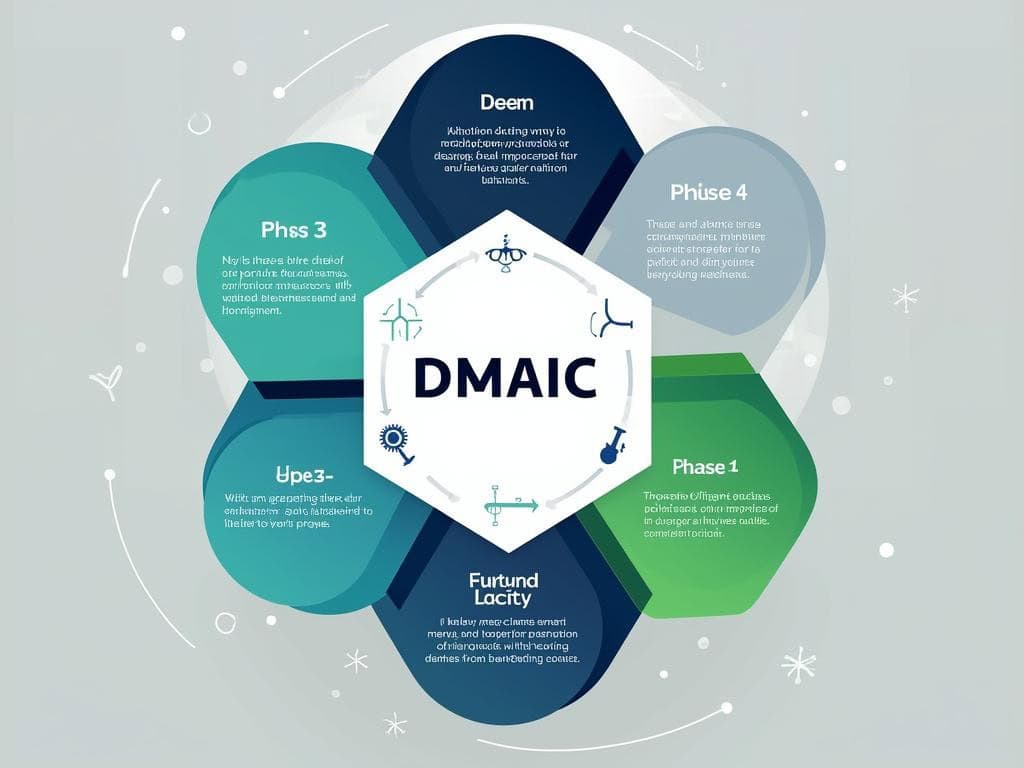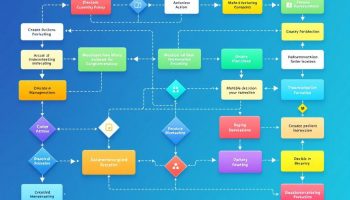
Understanding DMAIC for Business Process Improvement
DMAIC provides a systematic approach to improve business processes through a data-driven methodology that developed from quality management pioneers like W. Edwards Deming and Walter Shewhart. This effective approach gives organizations a complete framework for finding, analyzing, and fixing process challenges in many industries.
Key Takeaways:
- DMAIC offers a five-phase approach (Define, Measure, Analyze, Improve, Control) for structured process improvement
- The methodology enables data-driven decision-making by focusing on quantifiable metrics and root cause analysis
- Organizations can achieve significant cost reductions and efficiency gains through systematic problem-solving
- DMAIC can be applied across multiple industries, including manufacturing, healthcare, and financial services
- The approach builds a continuous improvement culture by providing a repeatable, standardized problem-solving framework
When properly implemented, DMAIC methodology transforms how you address operational inefficiencies. Each phase of the process guides you through identifying problems, collecting relevant data, and implementing lasting solutions. Modern organizations face increasing pressure to optimize processes while maintaining quality standards.
The structured nature of DMAIC helps eliminate guesswork from process improvement efforts. Instead of relying on intuition, you’ll base decisions on concrete evidence gathered through specific measurement techniques. This approach reduces the risk of implementing changes that don’t address the actual root causes of problems.
Success with DMAIC depends on proper training and consistent application across your organization. Teams that master this methodology develop valuable analytical skills that apply to numerous business challenges. The disciplined approach ensures that improvements aren’t temporary but become permanently integrated into your operational processes.
“DMAIC transforms complex process challenges into streamlined solutions through its structured, data-driven methodology, empowering organizations to achieve efficiency and cost reductions. By fostering a culture of continuous improvement, this five-phase approach serves as a pivotal framework for innovation across diverse industries.”
Historical Context and Evolution
DMAIC is used for systematically improving business processes and stands as one of the most powerful methodologies in the quality improvement toolkit. This structured approach evolved from the foundational work of quality management pioneers W. Edwards Deming and Walter Shewhart, who established the principles that would later form the backbone of Six Sigma methodologies.
Motorola revolutionized the business world when they popularized DMAIC in the 1980s as part of their Six Sigma initiative. The company faced intense competition from Japanese manufacturers and needed a systematic approach to improve quality. Their ambitious goal was to reduce defects to just 3.4 per million opportunities – a near-perfect standard that transformed how organizations approach quality management.
From Scientific Roots to Business Standard
DMAIC’s development didn’t happen overnight. The methodology draws heavily from the scientific method, with its emphasis on hypothesis testing and data-driven decision making. You can trace its intellectual lineage through several key developments in quality management:
- The Plan-Do-Check-Act (PDCA) cycle developed by Shewhart and refined by Deming
- Statistical process control methods that emerged during World War II
- Total Quality Management principles popularized in the 1970s
- Lean manufacturing concepts from the Toyota Production System
What sets DMAIC apart from other improvement methodologies is its rigorous, structured approach to continuous improvement and problem-solving. While similar to DMADV (Define-Measure-Analyze-Design-Verify), which is used for creating new processes, DMAIC specifically targets existing processes that need enhancement.
The methodology gained widespread adoption after General Electric’s CEO Jack Welch made Six Sigma central to GE’s business strategy in the 1990s. Since then, DMAIC has been used for process improvement across virtually every industry, evolving from its manufacturing origins to applications in healthcare, finance, customer service, and project management.
Today, DMAIC serves as the cornerstone of Lean Six Sigma initiatives worldwide. Organizations have adapted the framework to match their specific needs while maintaining its core principles of measurement, analysis, and data-driven improvement. The methodology’s continued relevance speaks to its effectiveness in tackling complex process problems through a systematic, measurable approach.
By understanding where DMAIC came from and how it evolved, you’ll gain valuable context for implementing this powerful methodology in your own process improvement projects.
Since the introduction of Six Sigma methodologies, organizations have seen significant reductions in process variation, leading to average savings of nearly $1 million per project.
forbes.com
The Five Phases of DMAIC
DMAIC offers a structured framework for process improvement that’s widely used across industries. This five-phase methodology provides you with a systematic approach to identify and address process inefficiencies. DMAIC is used for improving existing processes where the root causes of problems aren’t immediately clear.
Define Phase: Setting Clear Objectives
In this initial phase, you’ll establish project boundaries and objectives by:
- Creating a comprehensive project charter that outlines goals, scope, timeline, and team roles
- Identifying specific customer requirements through Voice of Customer (VOC) data collection
- Developing SIPOC (Supplier, Input, Process, Output, Customer) diagrams to visualize process boundaries
- Clearly defining the problem statement and expected business impact
The Define phase helps you focus your improvement efforts where they’ll deliver maximum value. By engaging stakeholders effectively, you’ll ensure alignment on project objectives before proceeding.
When defining process improvement goals, specificity matters. For example, rather than stating “improve customer service,” your goal might be “reduce customer complaint resolution time from 72 hours to 24 hours.”
The DMAIC used for problem definition establishes measurable targets that guide subsequent phases. This foundation enables data-driven decision-making throughout your project lifecycle.
The Measure phase follows with baseline performance assessment using tools like process capability analysis and Pareto charts. You’ll validate measurement systems to ensure data reliability.
In the Analyze phase, you’ll identify root causes using statistical tools and hypothesis testing. This leads to the Improve phase, where you’ll develop and test solutions before implementation.
Finally, the Control phase ensures sustainability through continuous improvement mechanisms like control charts and standard operating procedures. This prevents process regression and maintains gains.
DMAIC provides you with a systematic framework that eliminates guesswork from process improvement. By following these five phases, you’ll achieve measurable, sustainable results while building problem-solving capabilities within your organization.
Expert Insight: To effectively leverage the DMAIC framework for process improvement, begin with a well-defined Define phase that establishes clear project goals and stakeholder alignment. Prioritize specificity in your objectives, such as reducing customer complaint resolution time from 72 hours to 24 hours, to guide your measurements and ensure impactful results. Finally, maintain gains in the Control phase through continuous improvement practices like control charts, fostering a culture of data-driven decision-making within your organization.
Define Phase
The Define Phase sets the foundation for any successful DMAIC project. It’s the crucial first step where you’ll establish project boundaries, objectives, and expectations. When properly executed, this phase prevents scope creep and ensures everyone understands what the DMAIC is used for in your specific context.
During this phase, you’ll create a comprehensive project charter that serves as your roadmap. This document captures the problem statement, business case, goals, timeline, team composition, and expected financial benefits. You’ll want to include specific, measurable targets—reducing defect rates by 30% or improving process efficiency by 15%, for example.
Key Components of the Define Phase
Identifying customer requirements forms a critical part of this phase. You’ll need to determine both internal and external customer needs through tools like Voice of Customer (VOC) analysis. This helps you align improvement efforts with what truly matters to stakeholders. Effective stakeholder satisfaction depends on your ability to capture these requirements accurately.
The SIPOC diagram (Suppliers, Inputs, Process, Outputs, Customers) helps you visualize the entire process at a high level. This tool provides clarity on process boundaries and identifies key stakeholders. You’ll find it particularly valuable when collaborating with cross-functional teams on complex projects.
Before proceeding to the Measure phase, ensure you’ve:
- Clearly defined the problem in measurable terms
- Secured management support and resources
- Established a realistic project timeline
- Assembled a team with relevant expertise
- Created a detailed communication plan
Using a process mapping technique during the Define phase helps visualize the current state and identify potential improvement areas. This sets the stage for more detailed analysis in subsequent phases. For large-scale initiatives, effective project integration management becomes essential to coordinate all aspects of your DMAIC used for process improvement.
Remember that the Define phase isn’t just bureaucratic paperwork—it’s where you establish the foundation for success and gain organizational alignment. Investing adequate time here prevents costly redirections later in the project.
Projects with a well-defined scope are 48% more likely to succeed than those with unclear objectives.
hbr.org
Measure Phase
The Measure phase forms the foundation of your dmaic used for process improvement efforts. This critical second step helps you quantify existing performance before diving into analysis or implementing solutions.
You’ll need to establish reliable baseline metrics to accurately track progress throughout your improvement journey. Start by creating a comprehensive data collection plan that specifies exactly what information you need, where it comes from, and who’s responsible for gathering it.
Validating your measurement systems is essential to ensure you’re collecting accurate, reliable data. This typically involves conducting Measurement System Analysis (MSA) or Gage R&R studies to confirm your measurements are consistent across different operators and conditions.
Several key tools prove invaluable during this phase:
- Process mapping to visualize current workflows
- Process capability analysis to assess how well your process meets requirements
- Pareto charts to identify the most significant contributors to problems
- Control charts to understand process stability and variation
When collecting data, focus on both qualitative and quantitative information. Qualitative data helps you understand the human aspects of the process, while quantitative measurements provide statistical validation for your implementation approaches.
Key Measurement Activities
The Measure phase requires structured activities to build a solid foundation for improvement:
- Define performance metrics aligned with customer requirements
- Document the current process in detail
- Validate measurement systems for accuracy
- Collect baseline data on process performance
- Determine process capability and stability
- Identify variation sources and quantify their impact
This methodical approach ensures your dmaic used for decisions is based on solid evidence rather than assumptions. By establishing clear metrics early, you’ll be able to demonstrate tangible improvements during later phases.
Remember that the quality of your measurement directly impacts the effectiveness of your entire project. Rushing through this phase or collecting inadequate data can undermine even the most well-intentioned continuous improvement efforts.
The data collected during this phase will become your benchmark against which all future improvements will be measured. Take time to ensure you’re capturing both process inputs and outputs to fully understand the relationship between actions and results.
Expert Insight: In the Measure phase of the DMAIC framework, establish clear and reliable baseline metrics to effectively quantify current process performance. Develop a comprehensive data collection plan that specifies your information needs, sources, and responsibilities to ensure accurate and consistent data gathering. Prioritize validating your measurement systems through techniques like Measurement System Analysis and Gage R&R to build a robust foundation for meaningful process improvements.
Analyze Phase
The Analyze phase represents the critical investigative component where dmaic is used for uncovering the true sources of process problems. During this phase, you’ll transform raw data collected in the Measure phase into actionable insights that guide your improvement efforts.
When implementing the Analyze phase, you’ll need to employ both statistical and process analysis tools to identify root causes. This approach prevents solutions based on assumptions or gut feelings, ensuring your improvement efforts target the actual issues affecting performance.
Root Cause Analysis Techniques
Your analysis should incorporate several powerful techniques to identify underlying problems:
- Fishbone (Ishikawa) diagrams to visualize potential cause-and-effect relationships
- 5 Why analysis to dig beneath surface-level symptoms
- Failure Mode and Effects Analysis (FMEA) to prioritize failure points
- Statistical hypothesis testing to validate cause-effect relationships
- Process value analysis to identify non-value-adding activities
Effective root cause analysis requires both qualitative and quantitative approaches. You can conduct a root cause analysis by combining statistical validation with process expertise to create a comprehensive understanding of performance issues.
The dmaic used for process analysis typically employs data visualization tools that transform complex information into clear insights. These tools help you detect patterns, outliers, and relationships that might otherwise remain hidden in raw data. Regression analysis proves particularly valuable when examining how multiple variables interact to affect process outcomes.
A strategic approach to the Analyze phase involves mapping process flows and identifying bottlenecks where constraints limit overall system performance. This approach, rooted in Theory of Constraints principles, helps you focus improvement efforts where they’ll create the most significant impact. You’ll also want to establish a process improvement system that sustains gains over time.
The most successful Analyze phases engage cross-functional teams to examine problems from multiple perspectives. By involving representatives from different departments and specialties, you’ll uncover insights that might escape notice in a more limited analysis. This collaborative approach builds organizational consensus around the true causes of process issues.
Remember that the Analyze phase isn’t merely about finding problems—it’s about precisely identifying which specific factors contribute most significantly to performance gaps. This targeted approach ensures your improvement efforts in the next phase address the vital few causes rather than the trivial many.
Improve Phase
The Improve phase is where you’ll transform analysis into action, developing solutions that directly address root causes identified in your process. This phase is where DMAIC is used for making real, measurable changes that eliminate defects and enhance efficiency. You’ll move from understanding problems to implementing targeted solutions.
Developing Effective Solutions
During this phase, you’ll need to generate creative yet practical solutions. Begin with brainstorming sessions that encourage innovative thinking while keeping solutions grounded in data from previous phases. Prioritize solutions using criteria such as implementation cost, expected impact, and feasibility.
Potential improvement approaches include:
- Process redesign to eliminate unnecessary steps
- Automation of error-prone manual activities
- Implementation of error-proofing (poka-yoke) mechanisms
- Standardization of procedures to reduce variation
- Workflow optimization to improve efficiency
Before full-scale implementation, conduct pilot testing to validate that your solutions work as intended. This approach allows you to safely implement changes while minimizing disruption to ongoing operations.
The Improve phase requires clear documentation of proposed changes, including detailed implementation plans that outline resources needed, timelines, and responsibilities. Consider using project management tools to track implementation progress and manage project dependencies effectively.
Statistical validation remains essential during implementation. You’ll need to measure the effectiveness of solutions against baseline performance established in the Measure phase. This validation confirms whether your improvements deliver the expected results and provides quantifiable evidence of success.
Cross-functional teams play a crucial role in successful implementation. By involving stakeholders from different departments, you’ll gain valuable perspectives and increase buy-in for the changes. Effective active listening during this phase helps address concerns and overcome resistance to change.
Remember that the Improve phase isn’t about implementing every possible solution but rather focusing on changes that deliver maximum value with minimal resources. The DMAIC used for improvement initiatives should target specific root causes with measurable outcomes, creating a foundation for sustainable process excellence.
Control Phase
The Control phase represents the vital final stage in the DMAIC methodology, where you’ll secure the long-term success of your process improvements. This phase is where dmaic is used for establishing sustainable practices that prevent backsliding into old problems. Without proper control measures, even the most brilliant improvements can gradually deteriorate.
You’ll need to implement several key mechanisms during this phase. Start by developing comprehensive control plans that clearly document new procedures, responsibilities, and response protocols for process variations. These plans serve as your roadmap for maintaining improvements over time. Post-implementation reviews help verify that control mechanisms are functioning effectively.
Standard Operating Procedures (SOPs) provide detailed instructions for consistently executing the improved process. These documents eliminate ambiguity and ensure all team members follow the same standardized approach. When creating SOPs, focus on clarity and accessibility for daily reference.
Control Mechanisms and Monitoring Systems
Implementing effective control mechanisms is essential for sustaining process improvements. Here are critical components to include:
- Statistical Process Control (SPC) charts to monitor ongoing process performance and detect abnormal variations
- Regular auditing schedules to verify adherence to new standards and procedures
- Response plans that clearly define actions when processes deviate from acceptable parameters
- Visual management tools like dashboards to make process performance instantly visible
- Training programs to ensure all stakeholders understand new procedures
You’ll find that establishing proper document version control is crucial for maintaining current procedures and preventing outdated practices from resurfacing. The control phase also requires transitioning ownership of the improved process back to operational teams through formal handover procedures.
Remember that dmaic is used for creating lasting change, not just temporary fixes. The control phase often involves implementing mistake-proofing (poka-yoke) devices or methods that physically prevent errors from occurring. This might include redesigning equipment, adding verification steps, or implementing software validations.
For truly sustainable improvements, consider establishing regular process reviews where teams can identify new optimization opportunities. This creates a cycle of continuous improvement rather than a one-time fix. By thoroughly executing the Control phase, you’ll ensure that the hard work invested throughout the DMAIC process delivers lasting value to your organization.
Practical Applications and Benefits
DMAIC is used for solving complex business problems across diverse industries. This structured methodology delivers measurable improvements through its systematic approach to process enhancement. You’ll find DMAIC particularly valuable when tackling persistent quality issues, reducing operational costs, or streamlining workflows that affect customer satisfaction.
Industry-Specific Applications
Manufacturing organizations implement DMAIC for defect reduction, achieving significant quality improvements while minimizing waste. A leading automotive manufacturer applied DMAIC to reduce assembly defects by 67%, saving over $3.2 million annually through systematic problem analysis and targeted solutions.
Healthcare facilities leverage DMAIC to enhance patient safety and operational efficiency. By implementing DMAIC projects, hospitals have reduced medication errors by up to 85% and decreased emergency room wait times by 40%.
Service industries apply DMAIC to optimize customer interactions. Financial institutions have reduced transaction processing times by 35% through careful analysis of workflow bottlenecks and the implementation of standardized procedures.
The benefits of applying DMAIC extend beyond mere problem-solving. Here’s what you can expect:
- Significant cost reduction through elimination of waste and rework
- Enhanced process efficiency with streamlined workflows
- Improved quality leading to higher customer satisfaction
- Data-driven decision-making replacing gut feelings
- Systematic problem-solving capabilities across your organization
- Sustainable improvements through proper control mechanisms
DMAIC provides the foundation for building a continuous improvement culture within your organization. The structured approach ensures teams follow a consistent methodology, making complex problems more manageable through systematic breakdown.
When implementing DMAIC, select high-impact projects with clear, measurable outcomes. Begin with projects that address significant pain points but remain achievable in a reasonable timeframe. This balanced approach delivers quick wins while building organizational capability.
The versatility of DMAIC makes it suitable for virtually any process requiring improvement. Whether you’re reducing product defects, decreasing service response times, or minimizing financial errors, the DMAIC methodology provides the framework needed to identify root causes and implement effective solutions.
Industry Applications
DMAIC is used for transforming processes across numerous industries, providing a data-driven framework to tackle complex operational challenges. You’ll find this methodology delivering substantial improvements in various business sectors through its systematic approach to problem-solving.
Manufacturing companies have embraced DMAIC to drastically reduce defects and enhance product quality. For example, automotive manufacturers apply DMAIC to identify and eliminate assembly line inefficiencies, resulting in fewer warranty claims and improved customer satisfaction. The methodology helps production teams standardize processes, reducing variation and ensuring consistent output quality.
In healthcare, DMAIC delivers life-saving improvements through enhanced patient safety protocols and streamlined operations. Hospitals implement this framework to reduce medication errors, decrease patient wait times, and optimize resource allocation. By conducting thorough root cause analysis, healthcare facilities identify systemic issues that might otherwise remain hidden.
Financial services organizations utilize DMAIC to streamline transaction processing, reduce errors in account management, and improve compliance procedures. The methodology helps banks identify bottlenecks in loan processing workflows and implement controls that prevent costly mistakes in financial reporting.
Key Service Industry Applications
Service industries benefit significantly from DMAIC implementation. Here’s how different sectors apply the methodology:
- Call centers use DMAIC to analyze call patterns, identify training gaps, and implement standardized scripts that reduce average handling time.
- Retail operations implement DMAIC to optimize inventory management, reducing stock-outs while minimizing excess inventory.
- Logistics companies apply the framework to streamline routing, packaging, and delivery processes.
- Information technology departments utilize DMAIC to troubleshoot recurring system issues and implement preventative maintenance protocols.
Telecommunications companies have found particular success with DMAIC used for improving network reliability and customer service metrics. By integrating project management with data analysis, these organizations systematically identify and address signal quality issues and service interruptions.
The table below highlights the primary focus areas when applying DMAIC across different industries:
| Industry | Primary DMAIC Applications |
|---|---|
| Manufacturing | Defect reduction, quality control, production efficiency |
| Healthcare | Patient safety, wait time reduction, resource optimization |
| Financial Services | Error reduction, compliance, process standardization |
| Retail | Inventory management, customer service enhancement |
| Technology | Bug resolution, system reliability, development efficiency |
Strategic Benefits
The strategic advantages of implementing DMAIC methodology extend far beyond basic problem-solving. You’ll find that DMAIC is used for creating sustainable competitive advantages through its systematic approach to process improvement. Organizations leverage this methodology to achieve measurable improvements in operational performance while reducing costs.
Cost reduction represents one of the most compelling reasons DMAIC is used for business transformation. By systematically identifying and eliminating waste, you’ll experience significant savings in production costs, labor expenses, and material usage. Many organizations report 20-30% cost reductions through targeted DMAIC projects that address root causes rather than symptoms.
Enhanced process efficiency emerges naturally when you apply DMAIC‘s data-driven approach. You’ll eliminate bottlenecks, reduce cycle times, and optimize resource allocation through careful analysis and targeted improvements. The structured nature of DMAIC prevents the common pitfall of implementing solutions before fully understanding problems, ensuring your project performance improvements deliver maximum impact.
Customer-Focused Improvements
Improved quality and customer satisfaction form the cornerstone of DMAIC‘s strategic value. By defining requirements from the customer’s perspective, your organization will deliver products and services that truly meet market needs. This customer-centric approach helps you develop response strategies for opportunities that arise from improved quality.
The establishment of data-driven continuous improvement cultures represents perhaps the most valuable long-term benefit. DMAIC instills disciplined problem-solving approaches that become embedded in organizational DNA. Teams trained in this methodology develop stronger analytical skills and make decisions based on facts rather than opinions.
DMAIC provides these key strategic advantages:
- Reduced operational variance leading to consistent product/service quality
- Enhanced cross-functional collaboration through structured team problem-solving
- Improved employee engagement through participation in improvement initiatives
- Accelerated innovation through systematic process redesign
- Strengthened competitive positioning through operational excellence
The systematic problem-solving approach of DMAIC creates a framework that can be consistently applied across all organizational functions. This standardization ensures that improvement initiatives follow proven pathways to success rather than relying on ad-hoc methods that vary in effectiveness.
Implementation Recommendations and Next Steps
Your successful DMAIC implementation requires strategic planning and systematic execution. When selecting projects for DMAIC used for process improvement, prioritize high-impact opportunities with clear metrics and organizational support.
Project Selection Criteria
Choose projects that meet these essential criteria to maximize your DMAIC success:
- Projects aligned with strategic business objectives
- Clear problem statements with measurable financial impact
- Processes with significant variation or defect rates
- Issues with defined scope that can be completed in 3-6 months
- Projects with strong executive sponsorship
- Opportunities where data is available or can be collected
Before jumping into implementation, establish a strong project leadership structure with defined roles and responsibilities. This includes identifying Black Belt or Green Belt leads, executive sponsors, and cross-functional team members with process knowledge.
Building the right implementation roadmap significantly improves your success rate. Start with a comprehensive training program covering DMAIC methodology, statistical tools, and change management principles. Many organizations find continuous improvement initiatives fail without proper stakeholder engagement.
When executing your projects, follow these implementation steps:
- Develop a detailed project charter with clear boundaries
- Establish baseline performance metrics
- Validate measurement systems before extensive data collection
- Use appropriate analytical tools for root cause identification
- Test solutions through controlled pilots
- Create comprehensive control plans for sustaining improvements
Your DMAIC implementation should include a governance structure for reviewing progress, providing resources, and sharing lessons learned. Establishing regular tollgate reviews ensures projects stay on track and follow the DMAIC structure properly.
Common pitfalls to avoid include skipping phases, inadequate data collection, failure to validate root causes, and neglecting the control phase. Effective project communication throughout the implementation helps maintain momentum and organizational support.
After completing initial projects, create a system for tracking benefits and sharing success stories to build organizational momentum. Regularly conduct post-implementation reviews to identify what worked well and opportunities for improvement in your DMAIC approach.






